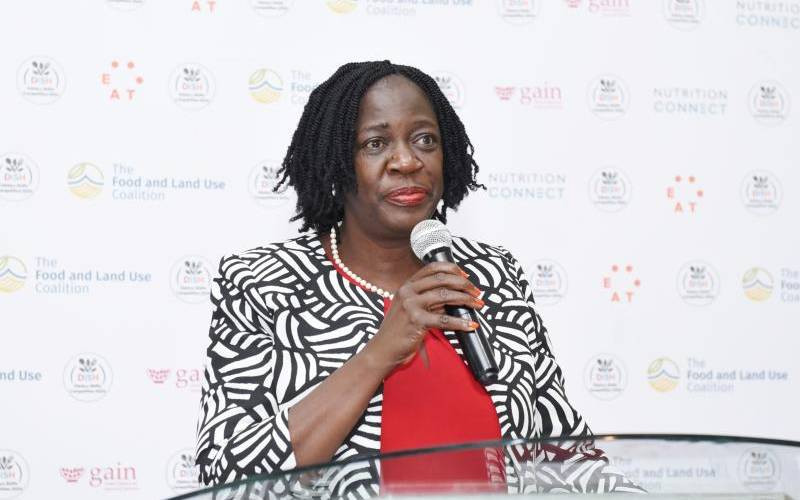
Global Alliance of Improved Nutrition (GAIN) Kenya Country Director Ruth Okowa, during an event held in November 2024 at Safari Park Hotel, Nairobi. [David Gichuru, Standard]
Good nutrition is the cornerstone of healthy living, productivity, and economic growth, yet Kenya continues to grapple with persistent and emerging nutritional challenges.
At a media roundtable convened by the Ministry of Health in collaboration with the Global Alliance for Improved Nutrition (GAIN) Kenya, stakeholders sounded the alarm on the country’s “triple burden of malnutrition”—undernutrition, micronutrient deficiencies, and the rapid rise of overweight and obesity.
Speaking at the event, Veronica Kirogo, head of the Division of Nutrition and Dietetics at the Ministry of Health, emphasised the need to fully integrate nutrition into Kenya’s social and economic development agenda if the country is to meet its development goals.
“Good nutrition reduces healthcare costs and boosts productivity. This translates into an annual loss of Sh 373.9 billion, or 6.9 per cent of our GDP as per the Cost of Hunger in Africa Study of 2019,” said Kirogo.
She noted that while Kenya has a strong legal and policy framework on nutrition, challenges remain in implementation and utilisation.
The effects of poor nutrition, Kirogo added, are far-reaching, ranging from an unhealthy workforce to poor school performance and an increased demand for curative health services.
A 2017 World Bank report highlights that every dollar invested in nutrition yields up to 22 dollars in economic returns through improved productivity, reduced healthcare costs, and enhanced cognitive outcomes.
- Epidemic in slow motion: Experts sound alarm over rise in NCDs deaths
- You love chips-kuku? Well, the government is coming for you
- Majority of Kenyans suffering from undetected diseases, experts warn
- Tax junk foods to tackle NCDs rise, experts urge State
Keep Reading
The 2022 Kenya Demographic and Health Survey (KDHS) paints a mixed picture: 18 per cent of children under five are stunted, 10 per cent are underweight, and three per cent are overweight.
Additionally, 42 per cent of pregnant women suffer from iron deficiency anaemia.
Although stunting, underweight, wasting, and childhood overweight rates have declined compared to previous years, progress remains slow.
Ruth Okowa, GAIN Kenya Country Director, expressed concern about the rising burden of diet-related non-communicable diseases (NCDs) such as diabetes, hypertension, and cardiovascular conditions.
“A particularly alarming trend is the rapid rise in overweight and obesity, driven by reduced physical activity and the growing consumption of unhealthy diets. These conditions not only strain our health systems but also erode family incomes and threaten the well-being of future generations,” she warned.
GAIN Kenya reaffirmed its commitment to working with national and county governments to strengthen nutrition-related policies and frameworks.
Its initiatives include supporting food fortification and biofortification programmes, advancing the Kenya Nutrient Profile Model (KNPM) for clearer food labelling, embedding food safety in county legislation, and improving supply chains for nutritious foods.
According to Okowa, these efforts are designed to create an enabling environment for healthier diets, reduce the burden of foodborne diseases, and tackle malnutrition.
Stakeholders concluded by urging policymakers to close enforcement gaps and keep nutrition at the top of Kenya’s political agenda, positioning it as a national priority for improved health and sustainable economic growth.
 The Standard Group Plc is a multi-media organization with investments in media
platforms spanning newspaper print
operations, television, radio broadcasting, digital and online services. The
Standard Group is recognized as a
leading multi-media house in Kenya with a key influence in matters of national
and international interest.
The Standard Group Plc is a multi-media organization with investments in media
platforms spanning newspaper print
operations, television, radio broadcasting, digital and online services. The
Standard Group is recognized as a
leading multi-media house in Kenya with a key influence in matters of national
and international interest.











